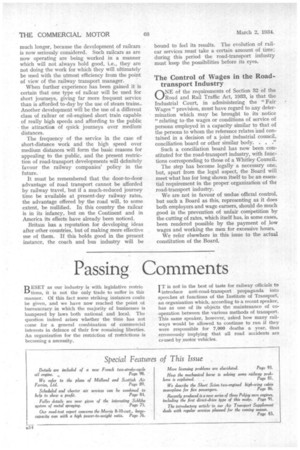An Attack on the Passenger Side
Page 27

Page 28

If you've noticed an error in this article please click here to report it so we can fix it.
IN recent years those engaged in the transport of passengers by means of coaches and buses have undergobe many trials and restrictions. Thanks to the vigorous efforts of the various associations, the results have not been quite so drastic as they might have been.
During this period the railway companies have, to some extent, improved the passenger-transport facilities over long distances, but short-distance and medium-distance journeys are often, still, protracted because very little effort has been made to improve these classes of service.
This state of affairs, which is in favour of roadtransport operators, may not obtain for very B13 much longer, because the development of railcars is now seriously considered. Such railcars as are now operating are being worked in a manner which will not always hold good, i.e., they are not doing the work for which they will ultimately be used with the utmost efficiency from the point of view of the railway transport manager.
When further experience has been gained it is certain that one type of railcar will be used for short journeys, giving far more frequent service than is afforded to-day by the use of steam trains., Another development will be the use of a different class of railcar or oil-engined short train capable of really high speeds and affording to the public the attraction of quick journeys over medium distances.
The frequency of the service in the case of short-distance work and the high speed over medium distances will form the basic reasons for appealing to the public, and the present restriction of road-transport developments will definitely favour the railway companies' policy in the future.
It must be remembered that the door-to-door advantage of road transport cannot be afforded by railway travel, but if a much-reduced journey time be available at present-day railway rates, the advantage offered by the road will, to some extent, be nullified. In this country the railcar is in its infancy, but on the Continent and in America its effects have already been noticed.
Britain has a reputation for developing ideas after other countries, but of making more effective use of them. If this holds good in the present instance, the coach and bus industry will be bound to feel its results. The evolution of railcar services must take a certain amount of time; during this period the road-transport industry must keep the possibilities before its eyes.
The Control of Wages in the Roadtransport Industry
ONE of the requirements of Section 32 of the Road and Rail Traffic Act, 1933, is that the Industrial Court, in administering the "Fair Wages" provision, must have regard to any determination which may be brought to its notice "relating to ,the wages or conditions of service of persons employed in a capacity similar to that of the persons to whom the reference relates -and contained in a decision of a joint industrial council, conciliation board or other similar body. . . ."
Such a conciliation board has now been constituted for the road-transport industry, with functions corresponding to those of a Whitley Council.
The step has become legally a necessary one, but, apart from the legal aspect, the Board will meet what has for long shown itself to be an essential requirement in the proper organization of the road-transport industry.
We are not in favour of undue official control, but such a Board as this, representing as it does both employers and wage earners, should do much good in the prevention of unfair competition by the cutting of rates, which itself has, in some cases, been rendered possible by the payment of low wages and working the men for excessive hours.
We refer elsewhere in this issue to the actual constitution of the Board.




























































































